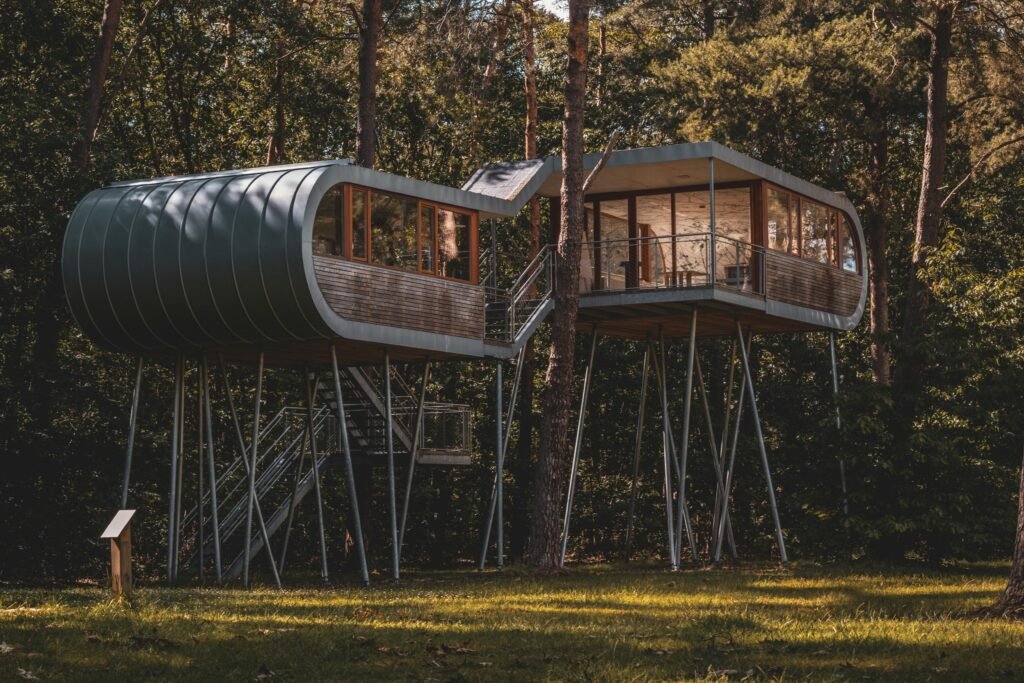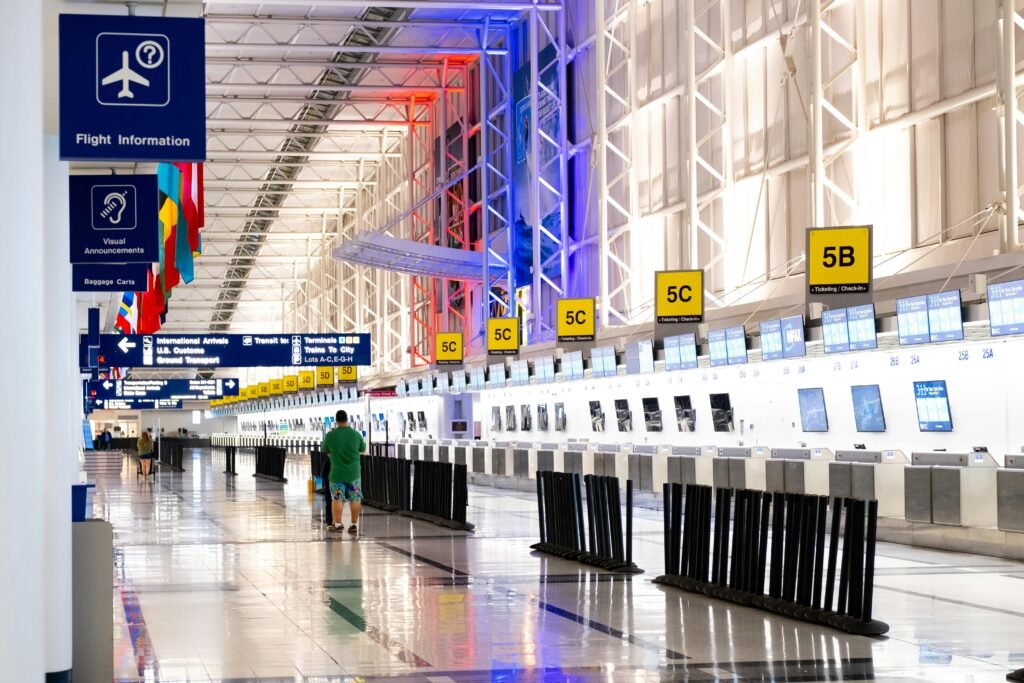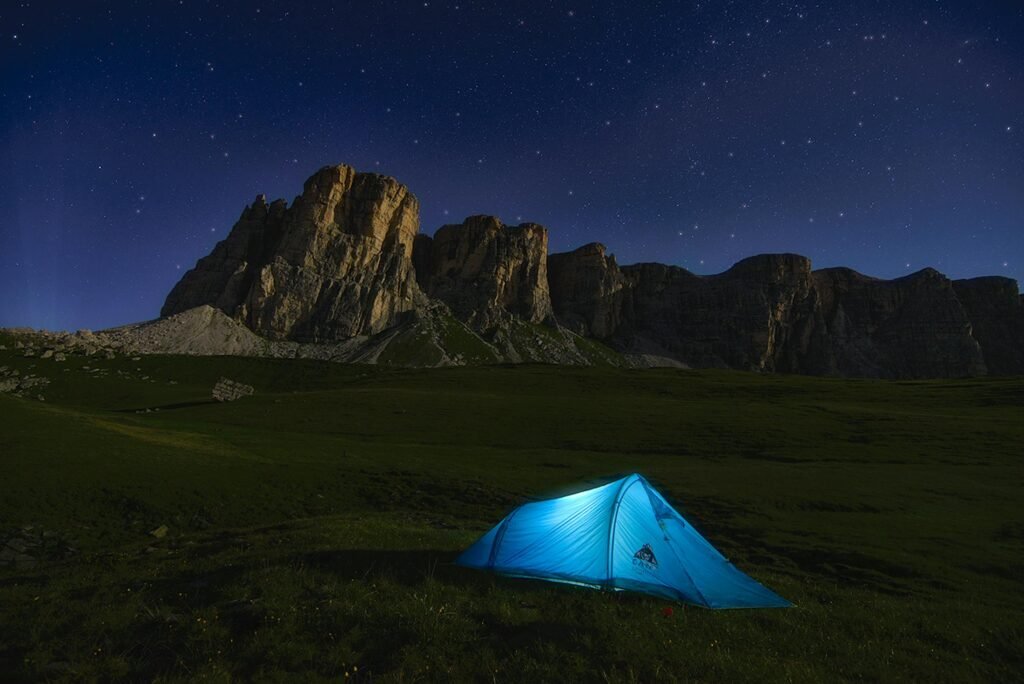Introduction to Unconventional Accommodations
Traveling allows individuals to explore the world beyond their familiar environments, inviting them to experience a myriad of adventures. One of the most intriguing aspects of travel is the opportunity to stay in unconventional accommodations that break the mold of traditional hotels and guesthouses. These unique lodging options not only provide a distinctive backdrop for a journey but also enhance the overall experience by adding an element of novelty and excitement.

As more travelers seek authentic experiences, the allure of unconventional accommodations has surged. From treehouses perched high above the ground, yurts nestled in remote landscapes, to converted buses or train carriages, each type of accommodation offers an opportunity to connect with nature or the local culture. These distinctive places often come with their own charm and history, creating lasting memories while catering to adventurous souls. This trend reflects a growing appreciation for creativity in travel and underlines the desire to venture beyond the ordinary.
In this blog post, we will explore a variety of some of the most unusual sleeping arrangements encountered around the globe. These fascinating locations will transport readers to regions and experiences that challenge the traditional notions of where one can rest their head for the night. Whether it is sleeping in a lighthouse overlooking the sea or a cozy igloo under the northern lights, the stories shared will highlight the diversity of unconventional accommodations and their appeal to those yearning for something out of the ordinary. Embracing these unique lodging experiences can transform a standard trip into an enriching adventure.
Treehouses: Living Amongst the Leaves
Sleeping in a treehouse is a unique experience that connects travelers with nature in an extraordinary way. Nestled among the leaves, these elevated structures provide a vantage point that offers a different perspective of the surrounding environment. My experiences in treehouses have been diverse and memorable, each uniquely illustrating the beauty and challenges of treetop living.

One of the most striking aspects of residing in a treehouse is the stunning view that comes with it. Waking up to the sunlight filtering through the canopy of leaves creates a tranquil atmosphere that is hard to replicate elsewhere. The sounds of nature—chirping birds, rustling leaves, and the distant call of wildlife—can serve as a gentle alarm, luring you from a peaceful slumber. This immersive experience fosters a sense of serenity that is both rejuvenating and inspiring.
However, residing high above the ground does come with its share of challenges. Navigating stairs, often steep and winding, can be daunting, especially for those unaccustomed to such a setting. Additionally, wildlife encounters are common; from the occasional squirrel peering in through an open window to the rustle of creatures moving about at dusk, sharing space with nature is both enchanting and, at times, unsettling.
Furthermore, the treehouse may not always provide the same level of comfort found in traditional accommodations. Amenities can be limited; for instance, electricity and running water might be absent, necessitating adaptations to one’s routine. These challenges, however, contribute to the overall adventure, allowing for a deeper appreciation of the natural world and a break from modern conveniences. In the end, the experience of sleeping in a treehouse is marked by a blend of thrill and tranquility, framing travel in a new light.
Airport Floors: The Art of the Layover
Traveling often leads to unexpected adventures, and spending the night on airport floors has become a rite of passage for many intrepid travelers. With layovers sometimes stretching into the early hours of the morning, sleeping in airports can be both a necessity and an experience filled with unique stories. While the idea of resting on cold, hard surfaces can be daunting, there are several strategies to make the experience more comfortable.

First and foremost, choosing the right airport can significantly enhance one’s layover experience. Some airports offer more comfortable seating, designated sleep areas, or lounges that welcome travelers for a nominal fee. These amenities can transform an otherwise uncomfortable night into a more bearable one. Additionally, travelers should invest in compact travel pillows and blankets, which can provide the necessary comfort when attempting to catch a few hours of sleep on the floor. A sleeping mask and earplugs can serve as further allies in blocking out distractions from the bustling terminal.
Over the years, I have shared these floors with a colorful array of fellow travelers. One particular encounter involved a group of backpackers passionately discussing their recent escapades while surrounded by makeshift camps of fellow passengers hunkering down for the night. Their antics filled the terminal with laughter, illustrating how camaraderie can arise in the most unconventional settings. Another memorable night featured a businessman meticulously spreading out his work documents on the floor, refusing to miss a single moment of productivity despite the unfortunate sleeping arrangements.
Ultimately, while the concept of sleeping on an airport floor may initially seem unappealing, with the right approach and mindset, it can turn into a valuable travel experience. Not only does it cultivate a sense of adaptability, but it also allows travelers to appreciate the diverse backgrounds and stories of those journeying alongside them. This unexpected aspect of travel fosters memorable encounters that make the adventure all the richer.
Desert Tents: Under the Stars
Sleeping under the vast, open sky in a desert tent offers a unique experience that merges serenity with the vast beauty of nature. The allure of an endless expanse of stars twinkling above is unmatched, especially when surrounded by the tranquil sounds of the desert. As I lay nestled within the cool fabric of my tent, the expansive heavens seemed to envelop me, creating a sense of connection to something timeless. The crisp night air was refreshing, filling my lungs with every breath as I gazed up at constellations that have guided travelers for centuries.

Waking up in this sandy oasis was equally enchanting. The gentle rays of the morning sun filtered through the tent’s fabric, casting soft shadows and slowly awakening the surroundings. The soft whispers of the desert breeze and the distant calls of wildlife added to the immersive experience. Emerging from the tent felt like stepping into a different world—a world where the simplicity of life harmonizes with nature’s beauty. Each moment spent in this environment further deepened my appreciation for the desert and its offerings.
Cultural elements permeate through the experience of sleeping in desert tents, as it often symbolizes traditional ways of life for many desert-dwelling communities. The tent itself is not merely shelter but a representation of local customs and stories passed down through generations. Engaging with local inhabitants, I learned about their traditions, the significance of hospitality, and their deep-rooted connections to the land. This interaction fostered a sense of respect for their culture, highlighting the intricate relationship between people and their environment. The experience was not just about physical comfort—it became a profound journey intersecting serenity, tradition, and a deep respect for the natural world.
Capsule Hotels: Futuristic Sleep Pods
Capsule hotels offer a unique and intriguing accommodation experience that is rapidly gaining popularity, especially among travelers seeking budget-friendly options in urban settings. These hotels feature compact sleeping quarters, or “capsules,” which can often be described as futuristic sleep pods. Each capsule is designed to maximize personal space while offering essential amenities, providing a comfortable resting place without the frills of traditional hotel rooms.

One of the most enticing aspects of capsule hotels is the privacy they afford. Each pod typically includes a sliding door, ensuring that guests can enjoy solitude within the confines of their capsule. The innovation of these sleeping arrangements allows travelers to have a personal space, while still being part of a larger communal living environment. Some pods are equipped with features such as mood lighting, power outlets, and even televisions, enhancing the overall sleeping experience.
While the concept may sound unorthodox, capsule hotels embody a sense of community and shared experience. Guests often find themselves in close proximity to fellow travelers, leading to unexpected yet enjoyable interactions. It is not uncommon to engage in conversations with international backpackers or exchange travel tips with local residents in the common areas. This communal vibe fosters camaraderie among guests, making each stay memorable.
In my own experience of staying at a capsule hotel, I was pleasantly surprised by the organization and cleanliness of the facilities. The shared bathrooms were well-maintained, and the communal lounge area offered a space to unwind and connect with others. This blend of privacy and togetherness encapsulates the essence of capsule hotels, making them an intriguing choice for modern travelers who seek both efficiency and connection during their journeys.
Overnight Buses: Riding the Night Away
Traveling by overnight bus can be an interesting, albeit challenging, experience. As you settle into the narrow seat of a moving vehicle, the reality of sleeping on a bus sets in. The rhythmic rocking of the bus can be lulling, but it often competes with jolting stops and the sounds of fellow passengers chatting or snoring. As you embark on these nocturnal journeys, navigating the territory of sleep becomes a unique challenge. The comfort level can vary significantly based on the type of bus and the route taken.

Often, overnight buses provide a sense of adventure that hotels simply cannot match. The seats may transform into reclining beds, sometimes with added footrests. Some operators offer amenities like blankets, pillows, and even snacks, enhancing the overall experience. However, it is essential to prepare for the unexpected. Travelers may find themselves squeezed in, sharing their space with strangers from diverse backgrounds, creating an environment rich in stories and interactions. From enthusiastic tourists to curious locals, each person presents an opportunity for a memorable encounter.
To enhance the likelihood of a restful journey, consider bringing a travel pillow and an eye mask. Noise-canceling headphones can also be beneficial in drowning out the ambient sounds of the road. Secondly, dress in comfortable layers, as the bus temperature can fluctuate. Lastly, travel with a small bag containing personal items such as toiletries and snacks to make the journey more enjoyable. These practical tips can aid in surviving overnight bus trips, allowing for a more pleasant adventure beneath the stars.
Unusual Homestays: The Quirks of Local Life
Traveling often leads to the discovery of remarkable accommodations that provide not only a place to sleep but also a unique glimpse into local culture. Unusual homestays, such as converted churches or creatively repurposed buildings, yield fascinating stories and experiences that go beyond standard lodging. For instance, staying in a decommissioned train station can spark memories of childhood adventures while highlighting the locale’s railway history. Guests are often welcomed by enthusiastic hosts keen on sharing stories, creating an intimate setting that enhances the stay.
One particularly memorable experience occurred during a trip to the countryside of Italy, where I had the privilege of staying in a transformed farmhouse. The structure’s rustic charm was balanced by modern comforts, and it was surrounded by sprawling vineyards. My host, a local vintner, conducted a private wine-tasting session that not only showcased the fruits of their labor but also immersed me in the nuances of local viticulture. Conversations during dinner revealed fascinating insights into the region’s traditions, making the visit much more enriching than merely sleeping there.
Moreover, unusual homestays can surprise travelers with unexpected amenities or quirks. For example, a night spent in a former lighthouse turned guesthouse provided beautiful ocean views, but the experience was enriched by the stories of maritime travelers that adorned the walls. Interacting with the lighthouse keeper, who shared tales of shipwrecks and sea legends, created a bond that transcended typical hospitality. Such unique lodgings illustrate how the character of a place and its people can enhance one’s travel narrative. As a result, unusual homestays often deliver stories and memories that are utterly unforgettable.
Eco-Lodges: Merging Comfort with Nature
Traveling often invites an array of unique lodging experiences, and eco-lodges stand out as a remarkable option that harmonizes comfort with sustainability. These accommodations not only provide a cozy atmosphere but also prioritize ecological preservation, offering guests a chance to immerse themselves in nature while minimizing their environmental footprint. Many eco-lodges boast innovative designs that utilize renewable resources and incorporate sustainable practices, encouraging a more conscientious way of living for both guests and the surrounding ecosystem.
During my travels, I had the pleasure of staying at several eco-lodges that exemplified the balance of luxury and eco-friendliness. One of my most memorable experiences occurred at a secluded eco-lodge nestled in the lush rainforests of Costa Rica. Here, waking up to the sounds of chirping birds and rustling leaves created a truly immersive experience. The lodge, constructed with locally sourced materials, seamlessly blended into its surroundings, while the open-air design allowed for natural ventilation and light. The commitment to sustainability was evident not only in the architecture but also in the lodge’s extensive recycling and composting programs, underscoring the importance of environmental stewardship.
Moreover, many eco-lodges offer opportunities to engage in local conservation efforts, such as tree-planting initiatives and wildlife monitoring programs. During one stay, I had the chance to participate in a local sea turtle conservation project, which involved protecting nesting sites and educating visitors on the importance of marine life preservation. Such experiences not only enrich the travel journey but also foster a deeper connection to the planet and its ecosystems. By choosing eco-lodges, travelers can enjoy comfort while also supporting sustainable practices that benefit both communities and the environment.
Reflections on Sleeping Weirdly: Lessons Learned
Travel often leads to unexpected experiences, particularly when it comes to accommodations. Throughout my journeys, I have found myself in some of the strangest places, each offering unique lessons that extend beyond the physical act of sleeping. These unconventional lodgings have taught me invaluable insights about adaptability, resilience, and the importance of embracing the unforeseen aspects of travel.
One of the most significant lessons learned is the value of flexibility. When faced with last-minute changes or unusual sleeping arrangements, being open to the experience rather than resisting it can transform a moment of discomfort into an opportunity for growth. For instance, sleeping on a train or in a tent may not have the comforts of a hotel room, yet these situations often foster a deeper connection with the surrounding environment and culture. Each peculiar resting spot brings with it stories and friendships that wouldn’t flourish in more conventional settings.
Additionally, these unconventional accommodations often serve as windows into local ways of life. For example, staying in a traditional ryokan in Japan or a yurt in Mongolia allowed me to engage with local customs and practices in a way that a standard hotel room could not. Sharing a meal with my hosts, participating in rituals, or simply exchanging stories far outweighed the inconveniences of unusual sleeping arrangements. These experiences underline the essence of travel — to immerse oneself in new cultures and to gain different perspectives.
Moreover, opting for unconventional lodgings often encourages genuine human interactions. Whether sharing a dorm room with fellow backpackers or staying with a family in their home, these settings promote camaraderie and connections that can last a lifetime. Such experiences emphasize that, despite the strangeness of a location, the inherent warmth of human connection can make even the most unexpected sleeping arrangements memorable.



